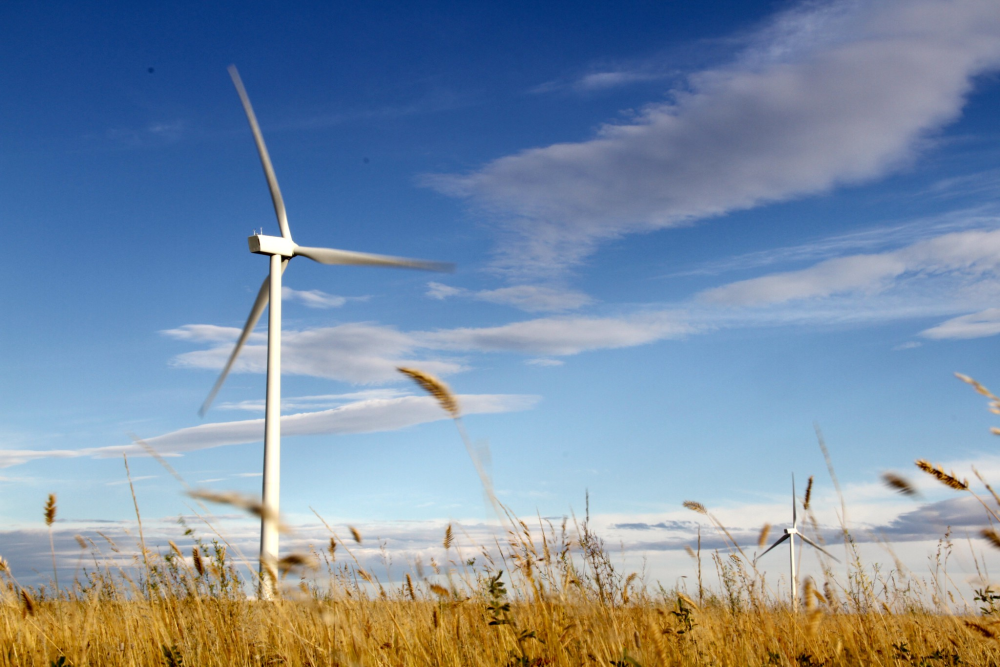 From pandas to pipelines to Olympic rings, our new executive director’s experiences vary wildly, but the constant throughout is her success at finding common ground to advance climate and environmental action. Linda Coady is known for her collaborative approach, which served her well in her work at Enbridge Inc., WWF-Canada, and the Vancouver 2010 Olympic and Paralympic Winter Games. Here, Linda shares insights from her past experiences (including in one of Canada’s biggest environmental protests), why she wanted to join the Pembina Institute team, and her views on how we can help Canada meet climate and energy challenges and opportunities in this extraordinary time.
From pandas to pipelines to Olympic rings, our new executive director’s experiences vary wildly, but the constant throughout is her success at finding common ground to advance climate and environmental action. Linda Coady is known for her collaborative approach, which served her well in her work at Enbridge Inc., WWF-Canada, and the Vancouver 2010 Olympic and Paralympic Winter Games. Here, Linda shares insights from her past experiences (including in one of Canada’s biggest environmental protests), why she wanted to join the Pembina Institute team, and her views on how we can help Canada meet climate and energy challenges and opportunities in this extraordinary time.
1. You are joining the Pembina Institute at a challenging time. How is the COVID-19 pandemic and the resulting economic crisis going to impact how the Institute works?
Like many other businesses and organizations in Canada today, Pembina Institute employees are working from home and following guidelines established by Canada’s public health officials. We have a dedicated and resilient team that is getting the work done online and while practicing physical distancing. We are incredibly thankful to all the front-line and essential workers risking their own well-being to respond to this crisis.
Like all Canadians, our primary concern is making sure we do our part in containing the impact of COVID-19 on our communities. But the extent to which the economic stimulus packages now being proposed for different sectors can also help lay the groundwork for a clean economy is key to determining how resilient we will be as a nation to future shocks and disruptions. So, opportunities for economic stimulus that drive clean growth are top of mind for us, and in our conversations with business, industry, governments and communities.
The Pembina Institute has its roots in Alberta which has also been particularly hard hit by the collapse in oil prices, with ripple effects throughout the Canadian economy. We will be putting a priority on working with our partners in industry, government and local communities to advance solutions that can provide economic and employment opportunities while supporting the transition to clean and low-carbon energy.
2. Why the Pembina Institute, and why now?
[subscribe:moo,align=right]I joined the Pembina Institute because the organization has a strong track record of working with others to develop practical and equitable solutions to energy and environmental challenges. Governments, business and communities in Canada now agree on the need to reduce greenhouse gas emissions and want to find ways to accelerate the transition to clean energy. The Pembina Institute has the knowledge, experience and opportunity to make a meaningful contribution to those solutions.
3. You have a long history in resource-based industry including at Calgary-based Enbridge Inc., one of Canada’s biggest pipeline and gas companies. What do you think industry needs in order to support energy transition?
Industry needs plans that can work. It’s good that we have reached the point where most people agree on the need for clean growth and the transition to a low-carbon future. But now the issue is “how” to do it. What I like about the Pembina Institute is the way the organization has always focused on the “how.” The other thing that has always impressed me is the Pembina team’s focus on establishing good working relationships with all of the different decision makers and stakeholders (in business, government, research institutions, non-profits and local and Indigenous communities) that can help make change move faster.
4. Some people think efforts to improve environmental and climate performance in the oil and gas industry, and in other sectors of Canada’s economy, will make industry less competitive which, in turn, could harm the economy. As someone with industry experience, what do you make of that view?
Actually, in my experience, very few people in industry and government take that view anymore. Most know the global energy mix is changing pretty rapidly now. Investment decisions are increasingly tied to climate performance and there is broadly based understanding that in order to compete in energy markets today, Canadian oil and gas – and other Canadian energy products, services and technologies – have to be able to demonstrate that they are among the cleanest in the world. So, we need both corporate and public policies that will achieve that goal in order to attract international investment.
5. You were at the centre of agreements that helped resolve some of the largest resource-based protests in Canada’s history, the Clayoquot Sound logging protests in the 1990s which drew international attention, and then later the conflict over forest conservation on the Great Bear Rainforest on the coast of B.C. While that was over 20 years ago it sometimes feels like the conflict over resource development in Canada can be just as polarizing today as it was then. What is your advice to people who want to reduce some of that polarization?
Look for common ground and, no matter how small it might be, use that common ground to build diverse coalitions. You need a purpose that people with different perspectives can see themselves in and get behind – in part because the status quos isn’t working for anyone, and in part because the potential solutions on the table are seen to represent a practical and equitable way forward. You also need to be able to scale up innovation and investment and bring new resources to bear on problems and opportunities. It is also worth noting that the new frameworks for forest conservation and management that you mentioned were characterized by strong Indigenous involvement and leadership over a 10-year period. The head of social innovation at the Stanford School of Business once observed that diverse coalitions and cross-sectoral collaborations are really messy, really hard and really complex. But they are also the only way that really difficult issues get solved.
6. As someone with deep experience driving sustainability efforts within industry, how would you characterize corporate Canada’s shifting attitude and willingness to act on climate change? Is there a difference between what’s said in the boardroom and what’s said publicly, and if so, what is it?
It’s changing more rapidly now but some companies are definitely out ahead of others. Recently we’ve seen large tech companies and a whole range of consumer-facing companies make some big moves and leadership commitments on the climate front. So, although what energy companies are doing is important, this isn’t just about them anymore. And while it may have been the case in the past that companies could say one thing and do another, that is getting a lot harder now in the face of increasing demand by banks, investors and insurers for improved transparency on climate risks. More and more financial institutions are using quantitative research and analytics to monetize climate risk and evaluate corporate performance on environmental, social and governance (ESG) issues. Corporate accountability in this space is a lot more rigorous than it used to be and is moving to a whole new different level as financial institutions look for resilience in corporate business strategies.
7. What do Canadians need to know about our energy future and the transition ahead of us?
First and foremost, Canadians need to see themselves in the energy transition and understand the role they play in it. How people use energy, and the type of energy they use, is changing in Canada and the rest of the world. This is not a new phenomenon but it is moving faster than it ever has before. Technology, policy and geopolitics – have always been transforming energy systems. And now we have climate change. We need to remember that there has and will always be a demand for energy systems and technologies that can provide access to affordable and reliable energy. What’s different is that markets are now demanding energy that is not only affordable and reliable, but also clean and addresses climate risk. There is a real opportunity at hand for Canadian leadership and innovation in meeting this new demand. And that leadership can, in turn, provide the basis for long-term prosperity in all sectors of the Canadian economy – in our cities as well as resource-dependent communities.
8. What will getting to net zero mean for Canadians across various sectors of the economy?
I don’t think anybody knows yet what net zero is going to mean in a Canadian context, or exactly how our economy and communities are going to get there. But the point is that whether you are in government, business or a community, it is important to be working on a plan to get there. A few years ago, some 400,000 Canadians provided their views on Canada’s energy future to Canada’s Generation Energy Council. I co-chaired that council and was very struck by the fact that the one thing Canadians overwhelmingly agreed upon was that we need a plan for our energy future that includes multiple pathways for achieving it. The federal government has embraced the goal of getting to net-zero emissions by 2050 and we now have a number of different communities and companies also embracing this goal. But net-zero by mid-century targets aren’t meaningful unless they can be backed up with plans that have outcomes that can be measured in 2025, 2030, and so on. Canadians need to be able to see a set of concrete actions with measurable indicators. The Pembina Institute can help support development of those plans, and we’re looking forward to more opportunities to work with companies, governments and communities on them.
9. What do people need to know about the Pembina Institute’s work for this year?
 The Pembina Institute is working on all of the major pathways to Canada’s energy future including energy efficiency, renewable energy, electrification, clean fuels and forms of transportation, green building codes and standards. We’re also working on policies and strategies for lowering emissions from Canada’s oil and gas products to meet the demand for energy while competing for market share in a 21st-century low-carbon economy. The teams in our five offices across the country are doing that work in partnership with municipalities, provincial governments, the federal government, local and Indigenous communities, business, and others in the non-profit sector. We are collaborating on projects to help electrify the grid, decarbonize transportation, support building retrofits, demonstrate the affordability and reliability of clean energy, and demonstrate the value created by reducing emissions from the oil and gas sector and other large industries. Most importantly, the Pembina Institute is working to depolarize the climate and energy discussion across Canada to ensure Canada demonstrates the kind of leadership on these issues that Canadians expect.
The Pembina Institute is working on all of the major pathways to Canada’s energy future including energy efficiency, renewable energy, electrification, clean fuels and forms of transportation, green building codes and standards. We’re also working on policies and strategies for lowering emissions from Canada’s oil and gas products to meet the demand for energy while competing for market share in a 21st-century low-carbon economy. The teams in our five offices across the country are doing that work in partnership with municipalities, provincial governments, the federal government, local and Indigenous communities, business, and others in the non-profit sector. We are collaborating on projects to help electrify the grid, decarbonize transportation, support building retrofits, demonstrate the affordability and reliability of clean energy, and demonstrate the value created by reducing emissions from the oil and gas sector and other large industries. Most importantly, the Pembina Institute is working to depolarize the climate and energy discussion across Canada to ensure Canada demonstrates the kind of leadership on these issues that Canadians expect.







